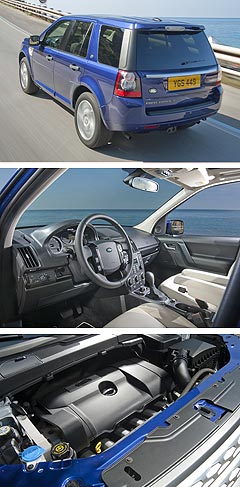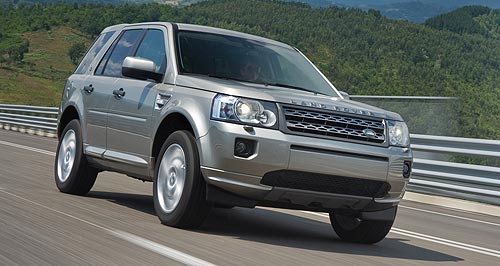Future models - Land Rover - FreelanderFirst look: Land Rover torques up FreelanderEvocative: There might be a lot of buzz around the all-new Evoque, but Land Rover has seen fit to apply some TLC to Freelander 2 for 11MY. Land Rover beefs up Freelander for 2011, but Australia misses out on 2WD model5 Aug 2010 By TERRY MARTIN LAND Rover has announced details of its facelifted ‘11MY’ Freelander small SUV, which will offer better performance and economy from its 2.2-litre turbo-diesel engine, improved refinement, upgraded idle-stop technology and a range of cosmetic enhancements. Due on sale Down Under in December, the 2011 Australian range will not, however, be available with the headline act of the upgraded Freelander 2 – its first ever two-wheel drive derivative. The front-drive model is dubbed the eD4 and will be the most efficient Land Rover ever produced, with Land Rover estimating a combined fuel consumption average of 6.0 litres per 100km from the base 110kW version of the PSA-sourced 2.2 diesel. At least until the smaller Evoque SUV is launched later in 2011, the CO2 emissions rating also falls below 160g/km for the first time for the Tata Motors-owned British off-road brand – to 158g/km. While Australian pricing and the full model range is still to be revealed, Land Rover Australia has confirmed to GoAuto that the eD4 will not be part of the launch brigade, but will consider it in future “if customer demand merits the introduction”. As it stands now, the 2011 Freelander will be offered in two states of tune for the 2.2-litre diesel, both of which offer 20Nm more torque than the current engine (from 400Nm to 420Nm).  In addition to the standard TD4, which climbs 2kW to 110kW, the ‘little Landie’ will also be available in SD4 guise, which boosts maximum power to 140kW. In addition to the standard TD4, which climbs 2kW to 110kW, the ‘little Landie’ will also be available in SD4 guise, which boosts maximum power to 140kW.The SD4 will be fitted standard with a second-generation Aisin Warner SWF21 six-speed automatic transmission (offering more efficiency and refinement, and faster shifts, according to Land Rover), while the TD4 will offer this as an option to its Getrag M66 EH50 six-speed manual gearbox, which has idle-stop as standard. Idle-stop technology is currently only available in Australia on the entry TD4_e model variant, but should be fitted standard wherever the manual diesel appears throughout the 11MY Freelander range. The system has been upgraded for 2011 with a bi-directional crank sensor and trigger wheel, which is said to result in improved sound quality and better responsiveness. It can also now operate in lower ambient temperatures (down from four to zero degrees Celsius). A range of modifications to the 2179cc 16-valve four-cylinder common-rail turbo-diesel – including a new water-cooled variable geometry turbocharger and a more powerful ECU – have contributed to improvements in the Freelander’s environmental performance, despite the extra grunt. Having said that, Australian-spec engines will only be compliant with the Euro 4 standard, not Euro 5 as is the case with the MY11 upgrade in Europe and the UK. As a result, the efficiency gains are only small for Australia with the 110kW TD4 manual, combined fuel consumption for which falls to 6.6L/100km (down 0.1L, compared to 0.5L with EU5) while CO2 likewise drops from 179g/km to 174g (compared to 165g with EU5). Both the auto TD4 and the auto SD4 come in at 7.0L/100km and 185g/km, which are comparable with the EU5 ratings. For the first time, Freelander’s diesel engine is also now compatible with 10 per cent bio-diesel, up from five per cent, while refinement should also improve with a cover now fitted to the sump to reduce radiated noise from the bottom of the engine. A redesigned front timing cover, the addition of an ‘injector sock’ and other measures were also undertaken to reduce noise, vibration and harshness levels. The Australian line-up will continue to offer a petrol engine variant, sticking with the current 3.2-litre 24-valve DOHC inline six-cylinder that has been recalibrated to meet the EU5 standard but has the same output and performance, including 171kW/317Nm, 10.7L/100km and 255g/km. The petrol-powered Freelander can also accelerate from 0-100km/h in 8.9 seconds, which is well ahead of the diesels, which range from 9.5 seconds in the 140kW SD4 to 11.7 seconds in the 110kW TD4 manual. The 2011 upgrade has brought a number of exterior and cabin revisions to the Freelander. On the outside, there is a redesigned front bumper (incorporating new foglamp bezels), revised grille (in a dark finish for TD4 and a brighter tone for SD4 and i6 petrol variants), new halogen projector headlights, modified tail-lights, a full-width tailgate appliqué, bigger wing mirrors, fresh 18- and 19-inch alloy wheel designs and three new exterior colour options (green, blue and white). The Land Rover logo also changes from gold on green to silver on green. Inside, the SUV has new seat trim options and revised instrument dials, all aimed at making the Freelander cabin feel more upmarket. The eD4 two-wheel drive variant will be available in the UK and other overseas markets from January next year. Land Rover managing director Phil Popham said: “The European market for two-wheel drive SUVs represents 23 per cent of the segment and we intend to compete strongly here. “A 2WD option is just one way in which we are developing our vehicles’ efficiency whilst adding to the Land Rover range and expanding our appeal to a broader group of customers.” Ranging in price from $45,590 to almost $60,000, the Freelander is positioned as a luxury compact SUV and hence does not compete in volume terms against Japanese rivals and other Europeans such as the Volkswagen Tiguan. The latest VFACTS figures show that Freelander sales are up 5.1 per cent after the first seven months this year, to about 600 units.  Read more15th of July 2010  Range Rover Evoque set for SydneyLand Rover says ‘Hello Sydney’ with all-new Evoque as final-phase testing beginsAll future models Alfa Romeo Alfa Romeo Abarth Abarth Audi Audi Aston Martin Aston Martin BMW BMW Bentley Bentley Chrysler Chrysler Chevrolet Chevrolet Dodge Dodge Citroen Citroen Ferrari Ferrari DS DS Ford Ford Fiat Fiat FPV FPV Foton Foton Haval Haval Great Wall Great Wall Honda Honda Holden Holden Hyundai Hyundai HSV HSV Isuzu Isuzu Infiniti Infiniti Jeep Jeep Jaguar Jaguar Lamborghini Lamborghini Kia Kia Lexus Lexus Land Rover Land Rover Mazda Mazda Maserati Maserati Mercedes-Benz Mercedes-Benz McLaren McLaren Mini Mini Nissan Nissan Mitsubishi Mitsubishi Peugeot Peugeot Opel Opel Proton Proton Porsche Porsche Renault Renault Ram Ram Saab Saab Rolls-Royce Rolls-Royce Smart Smart Skoda Skoda Subaru Subaru SsangYong SsangYong Tesla Tesla Suzuki Suzuki Toyota Toyota Volvo VolvoMotor industry news |
Click to shareLand Rover modelsResearch Land Rover All future models Alfa Romeo Alfa Romeo Abarth Abarth Audi Audi Aston Martin Aston Martin BMW BMW Bentley Bentley Chrysler Chrysler Chevrolet Chevrolet Dodge Dodge Citroen Citroen Ferrari Ferrari DS DS Ford Ford Fiat Fiat FPV FPV Foton Foton Haval Haval Great Wall Great Wall Honda Honda Holden Holden Hyundai Hyundai HSV HSV Isuzu Isuzu Infiniti Infiniti Jeep Jeep Jaguar Jaguar Lamborghini Lamborghini Kia Kia Lexus Lexus Land Rover Land Rover Mazda Mazda Maserati Maserati Mercedes-Benz Mercedes-Benz McLaren McLaren Mini Mini Nissan Nissan Mitsubishi Mitsubishi Peugeot Peugeot Opel Opel Proton Proton Porsche Porsche Renault Renault Ram Ram Saab Saab Rolls-Royce Rolls-Royce Smart Smart Skoda Skoda Subaru Subaru SsangYong SsangYong Tesla Tesla Suzuki Suzuki Toyota Toyota Volvo VolvoMotor industry news |
















Facebook Twitter Instagram